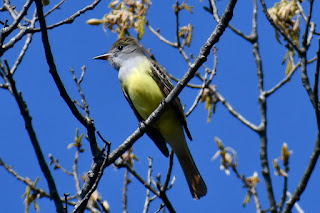Island Beach SP - 4/29/24: First Migration Push, Least Bittern and a Grasshopper Sparrow
Monday morning, I made my first survey of my yard and right away noticed several new bird arrivals for the year: Baltimore orioles, common yellowthroat, black-throated green warblers and a singing blue-winged warbler were moving through the trees gleaning insects from the foliage. I had a very early northern parula back in March, but now there were a few and they were singing. The first migration push for our area had finally arrived. I wound up tallying 45 bird species in the yard for the day, 46 actually when I heard the continuing Eastern screech-owl early in the evening. However, I spent the bulk of my day picking up new arrivals at Island Beach State Park.
The state park is a known migratory hotspot. I spent about five hours walking most of the bayside trails. I tallied 82 species for the day. That total included 14 new year birds, and two of those birds were new personal patch birds. The two birds that made my day at the park were a least bittern and a grasshopper sparrow. They are both rare for the park and brought my personal life total there to 287 species. The least bittern was also a new Ocean County bird for me. Other highlight birds from my day there were personal favorites: great crested flycatchers, black skimmers, red-headed woodpecker, scarlet tanager, white-crowned sparrow and rose-breasted grosbeaks.
Left, great crested flycatcher. Right, red-headed woodpecker. © S. Weiss
Scarlet tanager. © S. Weiss
I had run in to two friends at Reeds Road. It was the first stop for two of us and the last for the other. After finishing Reeds, Josh and I continued south. One of our stops was at Johnny Allen Cove trail, across from the park’s nature/interpretive center. About mid-way or so down the trail we spotted a pair of northern shovelers in the marsh. I was taking photos of these uncommon park birds when I heard a rustling in the reeds behind us. My mind was at first dismissing the cause of the rustling as a foraging flicker or something else less important than the two ducks that had my attention. But just a few seconds later, Josh excitedly called, “Least bittern!” I quickly turned around and saw the bird flying off farther back into the reeds. I saw the bird well enough to know it was a least bittern. Josh had seen it jump up from near the ground, on to reeds in front of him and then take off as I turned. The whole episode lasted a mere few seconds. Least bittern is much smaller and more secretive than American bittern. It is a rare bird for Ocean County, and more so for Island Beach. My research found only three other occurrences of least bittern at the park since 1967.
Crappy, unfocused pic of least bittern fleeing. © S. Weiss
Left, what a fleeing least bittern pic should look like, from Lake Apopka, FL on 8/14/2021. Right, least bittern at Forsythe NWR (NJ) on 7/9/2020. © S. Weiss
After the Johnny Allen trail we headed to our last stop for the day, Spizzle Creek trail. There we were finding birds to add to our daily lists, but nothing really unexpected. That was until we spotted a sparrow on the ground in the middle of the trail ahead of us. Our first impressions of the bird were a grasshopper sparrow. Its size and structure eliminated the other sparrows we had seen during the day, such as white-throated, chipping, field and song sparrows. The bird slowly worked its way along the trail, staying ahead of us and getting obscured by taller grasses along the trail edges. I wanted to rule out the two marsh sparrows, saltmarsh and seaside sparrows, before making a final identification. At the time, we had the trail to ourselves and stayed with the bird, taking many photos as we followed it. We finally had photos showing a somewhat large bill, an eye ring and a yellowish forehead to solidify our initial impression identification. There are fewer locations in Ocean County to find grasshopper sparrow than just a few years ago, and they have always been a rare find at the park. My research only found six other occurrences of this species here since 1969, and only two of those were spring records. The marsh trail is not the sparrow’s normal habitat, but it is migration and birds sometimes just drop in at unexpected spots after a long flight.
Grasshopper sparrow. © S. Weiss
The bittern and sparrow brought my park life total to 287 species, and the bittern brought my county life total to 334 species. Not bad for the first migration day.











Comments
Post a Comment